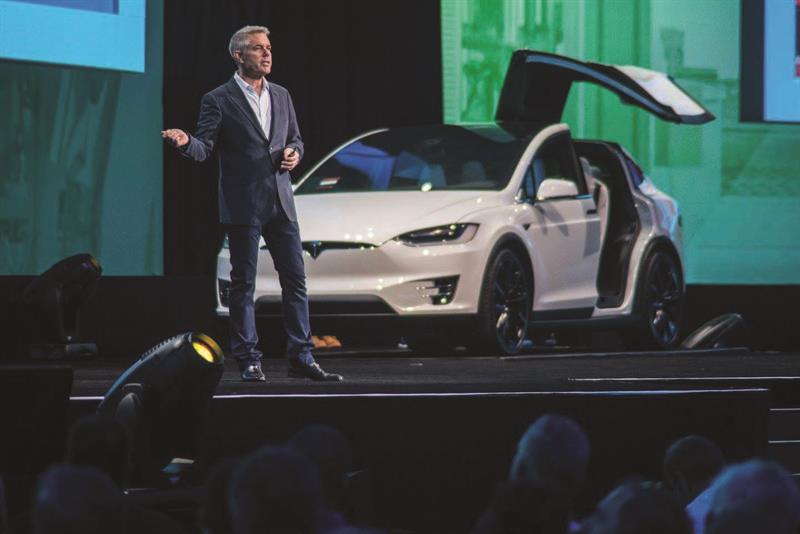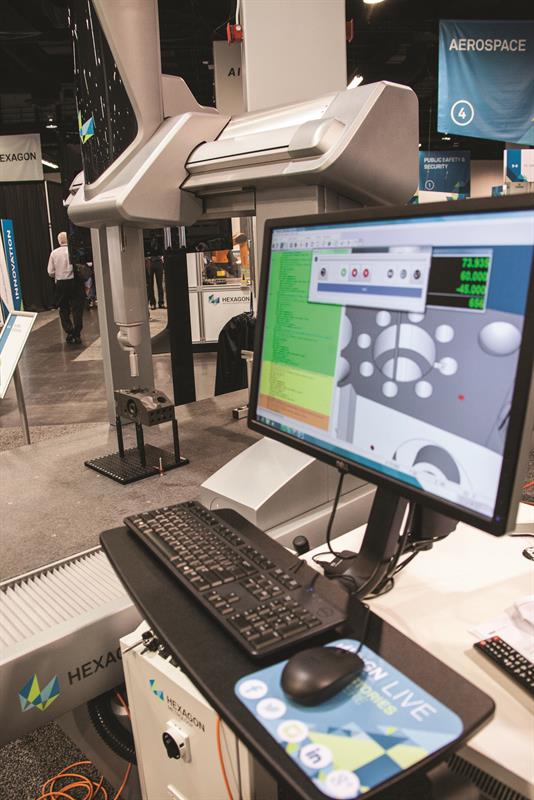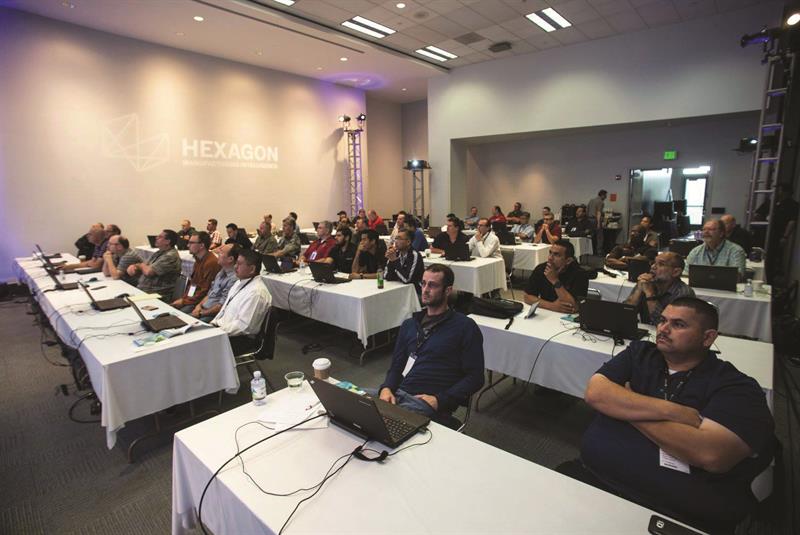Ola Rollén took to the stage for an evening of storytelling at the June event held in Anaheim, California, USA. The abridged story is that Hexagon Manufacturing Intelligence aims to collect manufacturing data and then, in a feedback loop, update manufacturing processes in ‘autocorrect’ fashion. This holistic capability is what the company effectively encapsulated in its name change from Hexagon Metrology to its present name last year (see box, below). Stated thus, the story doesn’t sound so captivating, but the way Rollén relayed the story, in eloquent fashion, adds greater weight to it, so let’s follow his tale.

Ola Rollén, Hexagon AB president and CEO, uses a Tesla X as a prop during his presentation
The theme for the previous Hexagon Live events has been ‘great stories start here’, the CEO told the assembled audience, who offered this year to tell them a story – in fact he told several connected stories. The first was a fairytale with a beginning and an end, but with no middle. This bare-bones narrative “lacks data”, Rollén says, and goes on to add that missing data, but in doing so subsequently delivers detail after detail devoid of narrative. And this is the central premise of his opening speech: bringing data and narrative together. “The whole story can change our perception, inform our decisions and, ultimately, lead to better outcomes,” he suggests, underlining this as delivering “the power of the whole story”, with Hexagon Manufacturing Intelligence one of very few companies in the world that understands and can offer this; the delivery of an end-to-end solution.
In referencing the film ‘The Martian’, Rollén talks about unsolvable problems: 140 million miles from Earth, 50 days of food, no water, no plants; rescue four years away, if at all. “And this has three parallels with you,” he told the audience, saying that all attending the conference are on some sort of mission, that this mission will be tested and challenged by change, and that the outcome of the mission can be shaped by the whole story.
When faced with an unsolvable problem, you start with two statements, he offers: ‘we can’t, because’, which in the case of The Martian is because it’s 140 million miles each way and the hero, played by Matt Damon, will run out food before a rescue; and ‘we can, if’, if you fix it one step at a time – and that is what ‘The Martian’ is about, Rollén highlights.
He continues: “If we define an unsolvable problem as a gap, the distance between what is and what should be, then we can start tackling it. And that is how we describe our business model; we want to bridge the gap.”
And that gave the CEO his entrée into a presentation about how this gap can be filled by use of the company’s technologies. “We have three components that we can give you to fix an unsolvable problem. The first is raw material in the form of data; 2D, 3D, time and events, so suddenly we have ‘5D data’. We also need to connect the data, using enablers – connectivity, automation, artificial intelligence and business information intelligence. Most companies stop here, but we want to take it further; we want to create a solution [by providing a feedback loop]. But we need to create a narrative of why we should do this, and that is why you are all here at Hexagon Live, to discuss that narrative of how you solve problems.”

And the automotive industry is faced with challenges. It is growing such that the projected volume of cars produced in 2023 will be 107 million, as against 60 million in 2009 and 88 million in 2015; so 78% growth from 2009. In addition, he adds that consumers want to change their cars more often for newer models, so there is also growth in the number of models. Since 1997, the number of models has grown by 250%, while the lifespan per model has fallen by 50%. And in making these huge volumes of cars, “they are made to perfection; they are really reliable”, he stresses, and underlines that achievement by saying that there are one million discrete components in the Tesla X that he emerged from at the start of this portion of his tale.
Measurement and data are at the root of today’s carefree motoring. “In an internal combustion engine, there are 35,000+ measured characteristics alone”, Rollén highlights, explaining that, at the volume these are made, there are tens of millions of values (data points) captured daily. And he pushes home the point: “We have tons of data that we are not using efficiently enough, and this presentation is about improving the manufacturing industry. But in order to understand how we can improve, I need to tell you the story about how you build a car or dishwasher etc.”

This, he says, always starts in the minds of the design teams, with this realised in a CAD model. But to maintain safety, this design data is sent to CAE software, with subsequent alterations made to various elements. This updated model is returned to the CAD system, with the next step after that being CAM, with the output from that being the data required to drive machine tools or robots that undertake production. Physical products are the outcome of this, and that is where metrology is employed and more data created to support a pass or fail status.
WHY THE REWRITE?
Okay, that sounds normal. So why does this story need rewriting, Rollén rhetorically asks. He explains this by referencing a picture of a car bonnet that has Post-It notes attached to it, indicating that this is the ramp-up to production of a car. “Is it big data or small data? There is definitely room for improvement,” he states, adding that: “In 2016, where the average car plant had investments of billions of dollars, the engineers are still using Post-It notes to figure out what to do and correct stuff. We can do a lot to improve this process. We believe we should put metrology data to work, but we need to answer three fundamental questions: what else can we connect; what else can we automate; and what ‘intelligence’ can we manufacture? And then we need to start saying ‘we can, if’.
“We can, if we connect isolated islands of information that reside throughout the manufacturing chain, then everyone can see the whole picture and we can start improving the process and get rid of the Post-It notes.”
But there is some missing information, Hexagon AB’s top man suggests, instancing the quality function, specifically the quality manager with limited staff and limited power, as compared to the production manager and production staff. The two sides do come together at daily, weekly or, at worst, monthly meetings, with further delay as the production manager reviews any quality reports. Whatever problems exist, though, they continue until the production manager takes action. Increased costs or reduced profits are the result. “We need to put our metrology data to work, as it is our single source of truth in the production chain,” the CEO underlines, adding: “We are going to put the metrology data straight into the CAM software where we can reprogram or readjust machines – a feedback loop, or autocorrect.” And he reveals that the company is running tests now to support such an approach, adding: “The beauty of this new product is that a plant that is run like this is going to get better and better over time. It will produce less and less scrap and use fewer and fewer hours in producing scrap. A self-teaching process.”
LEARNING FROM THE PAST
The other benefit to this, he says, is that with the projected increasing number of car models, with more information it will be possible to draw lessons from the previous product about what to do and what to avoid in the design process.
To graphically underline this point, he refers again to the Tesla X, bringing up on screen the 2012 prototype and the 2015 production model, between which there are visible and significant differences. There were more than 7,000 alterations between the two cars, reveals Rollén, who adds: “That slows down the process of launching new products, so that if we had a feedback loop speeding this up, a car company could launch more new models in a shorter period of time.”
So, the rewritten manufacturing story is about putting metrology data to work in an intelligent manufacturing feedback loop where quality drives productivity improvement and will transform from a mere tale to reality with a successful conclusion to Hexagon Manufacturing Intelligence’s current test development that links metrology with CAM.
TEXT BOX: What’s in a name?
In 2015, Hexagon Metrology became Hexagon Manufacturing Intelligence (01952 681300). This change represented the evolution of its brand; the culmination of a number of changes that have taken place over the last few years and the embodiment of the company’s continuing vision “to realise truly data-driven manufacturing”.
As Hexagon Metrology, the company’s core competence was dimensional metrology, the firm offers, adding: “But now, our customers want more. You need to work in smarter ways and are looking for partners to help you develop better products more efficiently and more cost-effectively. You need to get products to market faster and be more competitive. You want expert support to achieve productivity goals.”
Hexagon Manufacturing Intelligence can help, because it now takes in expertise in new areas like statistical process control and CADCAM software (Hexagon acquired Vero Software in July 2014). “Although closely linked to metrology, these new capabilities take us beyond quality checking. They are about actively improving manufacturing and enabling customers to work in smarter ways. They are about driving productivity. They are about manufacturing intelligence,” the company statement says, underlining exactly from where its new name hails. And the statement continues: “This ability to inform and effect change is the key difference between the value proposition of Hexagon Metrology and the value proposition of Hexagon Manufacturing Intelligence.
Our rebrand reflects our growing expertise, ability to offer integrated industrial manufacturing solutions, and ambition to continue innovating. The rebrand to Hexagon Manufacturing Intelligence also aligns our business more closely with Hexagon’s overall strategy to offer software-centric information technology solutions that improve quality and productivity across entire industry workflows.”
This article was originally published in the October 2016 issue of Machinery magazine.










